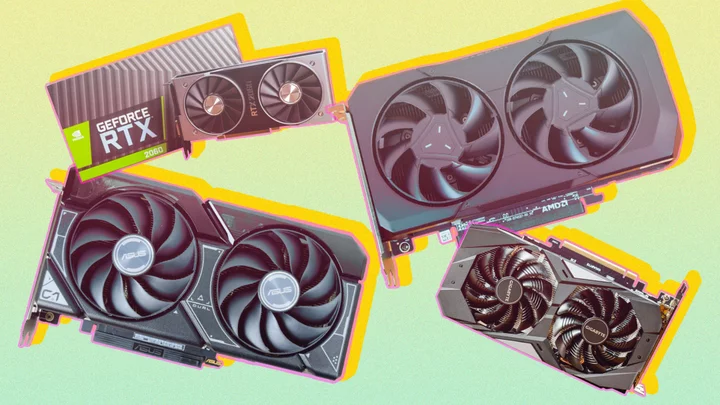With the Nvidia GeForce RTX 4060 joining the AMD Radeon RX 7600 in 2023, we have a new landscape for mainstream graphics cards. Notably, with the RTX 4060's introduction, now four generations of Nvidia xx60-class GPUs are in serious rotation in modern gamers' PCs. According to the latest Steam Hardware Survey, the GTX 1060, the RTX 2060, and the RTX 3060 occupy three of the top five slots for the most-used cards on the market. In a competitive graphics-card field dominated by Nvidia, the arrival of a new equivalent to that trio is a big deal.
Is this finally the right time to upgrade your gaming PC to the new best graphics card for you? Is the performance boost from the RTX 4060 high enough to justify retiring that GTX 1060 or RTX 2060? Do these older cards still have staying power relative to the 2023 card?
We'll answer these questions by pitting the RTX 4060 (as well as the Radeon RX 7600) against the last three generations of Nvidia’s equivalent cards, comparing them in terms of both price and performance. Spoiler alert: It should come as no surprise, but the new cards are hands-down better in all regards—even pricing.
Mainstream GPUs Compared: Time To Upgrade?
Determining when is the right time to upgrade your graphics card is challenging for any PC gamer. If your new games suddenly just aren't running as fast as you’d like, that might seem like the right time. Even then, though, you have to determine the right card and if it's worth it to wait for the next generation of cards, or to buy now.
(Credit: Michael Justin Allen Sexton)With the launch of AMD’s Radeon RX 7600 and Nvidia’s GeForce RTX 4060, now is an excellent time for many gamers on older cards to upgrade and to put those aging RTX 2060, Nvidia GeForce GTX 1660, and GTX 1060 cards to rest. But I keep an eye on what people are saying around the web, and it seems not everyone is convinced. In particular, I’ve seen lots of scrutiny about how much of value these cards hold, with many balking that they don’t produce enough performance relative to their price.
Spoiler alert: It should come as no surprise, but the new cards are hands-down better in all regards—even pricing.With our historical benchmark results, I'll provide clarity on just how much performance and value you get by buying either an Nvidia GeForce RTX 4060 or an AMD Radeon RX 7600. I also aim to make clear the big performance difference these cards have over previous generations.
(Credit: Michael Justin Allen Sexton)Detailing all of the architectural changes among these cards here would be too long and cumbersome to be worthwhile. If you’re interested in the cards from that perspective, see our reviews for the individual cards.
Instead, I'll focus on how much of an upgrade you can expect to see coming from the likes of an Nvidia GeForce GTX 1060, RTX 2060, or Nvidia GeForce RTX 3060. Of course, pricing on the cards will be a focus, as well, to determine the inherent value of these 2023 GPUs versus those earlier three. Are these new entry-level GPUs overpriced? The proof will be in the numbers.
The Graphics Cards Tested Here...
Asus Dual Nvidia GeForce RTX 4060 OC Edition Review
4.5 OutstandingAMD Radeon RX 7600 Review
4.0 ExcellentEVGA GeForce RTX 3060 XC Black Gaming 12G Review
3.5 GoodNvidia GeForce RTX 2060 Founders Edition Review
4.0 ExcellentZotac GeForce GTX 1660 Super Twin Fan Review
4.0 ExcellentNvidia GeForce GTX 1060 (Founders Edition) Review
4.0 Excellent See all (6 items)GPU Testing Setup
All of the cards in this article were tested on our 2022 GPU test bed that runs a stock Intel Core i9-12900K processor with a 240mm Corsair Hydro Series H100X water cooler on an Asus ROG Maximus Z690 Hero motherboard. The system has 32GB of Corsair Vengeance RAM clocked at 5,600MHz, a 1TB Corsair MP600 Pro NVMe 4.0 SSD, and a Corsair HX1500i 1,500-watt 80 Plus Platinum power supply. All tests were performed running on Windows 11 Pro with all of the latest updates.
Pricing is key to any graphics card's success or failure. We are of the mindset that you can't find any truly bad graphics cards—just some with better value and pricing than others. That said, energy efficiency is also a factor, as it can enable long-term cost savings with less heat and therefore less cooling, and might require a smaller power supply. While most gamers aren’t all that concerned about how much power their graphics card consumes, I've taken this into consideration for the sake of a comprehensive evaluation.
For now, let’s put power aside and consider just prices for the moment. AMD’s Radeon RX 7600 launched at an MSRP of $269, and Nvidia’s GeForce RTX 4060 released at $299. Many have called these prices out for being high, but historically that’s actually not true. Compared with the last several generations of Nvidia’s xx60-class graphics cards, both the RX 7600 and RTX 4060 are reasonably priced even if you don’t take performance into consideration.
Nvidia’s GeForce GTX 1060, for example, launched priced at $249, which I adjusted for inflation to May 2023 using the U.S. Bureau of Labor Statistics inflation calculator. This produced a price of around $315 when adjusted. Nvidia’s GeForce GTX 1660 was a bit more affordable at its launch costing just $219, or about $262 in today’s money, but the RTX 2060 and RTX 3060 were far costlier. Nvidia’s GeForce RTX 2060 launched priced at $349, which would be roughly $422 today, and the RTX 3060 isn’t much better, launching at a price of $329. That equates to $380 when adjusted for inflation.
(Credit: Zlata Ivleva)Though we always love to see lower prices, I don’t realistically see a solid, logical reason to be disappointed in the prices placed on the RX 7600 or RTX 4060. This pricing information suggests that the launch prices of the RX 7600 and RTX 4060 are both well within the price range that Nvidia targeted with the last several xx60-class graphics cards, and they are even significantly lower than the last two generations.
(Credit: Zlata Ivleva)Both new cards are clear winners on the performance front, too. This shouldn’t really come as a surprise, but the extent to which they are faster is quite telling when compared with the last few generations.
Nvidia RTX and AMD RX Benchmarks: Synthetic Tests
Synthetic benchmarks help to show a graphics card’s potential, but they aren’t representative of real-world gaming performance. As we are mostly looking at multiple generations of Nvidia’s xx60-class graphics cards, we don't have much to say about the synthetic scores. The newer cards performed far better than the older cards, and this suggests they should be faster. This is true, of course, but I'll touch on this in more detail in the next testing section.
Among these benchmarks, the only odd result recorded was the AMD Radeon RX 7600’s poor performance in LuxMark. So, maybe don’t buy an AMD Radeon RX 7600 if you sometimes need to use your graphics card for GPGPU work. The RX 7600 performed just fine in other tests, though, and proved to be neck-and-neck with the RTX 4060.
Nvidia RTX and AMD RX Benchmarks: Game Tests
We opted to look at a reduced set of games in this article, partially for consistency. We test newer cards with a wider range of games and specifically test DLSS, DLSS 3, and FSR as well as ray tracing performance. But the GTX 1060 and GTX 1660 don’t support DLSS or ray tracing. Technically we could have tested all of the cards with FSR, but doing so would only give mixed and indecisive results without including DLSS testing. As a result, we opted to leave off those tests entirely.
We did keep one game with ray-tracing support in the mix just for an idea how that’s changed since the release of the RTX 2060, Nvidia’s first xx60-class card to support ray tracing. In F1 22, you can see the RTX 4060 had a large performance advantage at 1080p, which steadily declined as the resolution was increased. The RTX 4060 was roughly 26% faster than the RTX 3060 at 1080p, 22% faster at 1440p, and 18% faster at 4K. Due to the more limited bandwidth on the RTX 4060, its performance dropped faster with changes in resolution, but it was still sufficiently fast to hold a decisive win.
AMD’s Radeon RX 7600, which is also a bit bandwidth-starved, was also hit harder by higher resolutions, with it holding the second place in the charts at 1080p and 1440p, only to then tie for last at 4K.
Things improved for AMD’s Radeon RX 7600 in games that don’t support ray tracing, while they worsened somewhat for the RTX 4060. The RTX 4060 still managed to perform well in the rest of our games, but it simply didn't enjoy as large of a performance lead in games that lack ray-tracing support. In Total War: Three Kingdoms, the RX 7600 and RTX 4060 were neck-and-neck across the board, with each holding a 20% and 17% lead over the RTX 3060, respectively.
The older GTX 1660 and GTX 1060 cards were able to only operate at a fraction of the RX 7600 and RTX 4060’s speed. Both the RX 7600 and RTX 4060 were more than twice as fast as the GTX 1660, with the older GTX 1060 even further behind. The RTX 4060 maintained a similar lead over these older cards in Red Dead Redemption 2 and Shadow of the Tomb Raider. In Far Cry 5, the RTX 4060 was also far faster than the GTX 1660, but it didn't quite deliver twice the performance of the older, slower GTX 1660.
AMD’s Radeon RX 7600 for its part also turns out impressive performance numbers against the older Nvidia 60 Series cards. We encountered issues while trying to test the game in Red Dead Redemption 2 related to the game not detecting the card correctly. However, in Shadow of the Tomb Raider, the RX 7600 was 89% faster than the GTX 1660 at 1080p. In Far Cry 5, the RX 7600 actually turned in the best performance of any card tested, and it even slightly outpaced the RTX 4060.
Nvidia RTX and AMD RX Benchmarks: Legacy Game Tests
Performance in older games doesn’t always improve with newer hardware. Game optimization in drivers is important and can be the decisive factor when it comes to running older titles. This is the older GPUs' time to shine...well, some of them.
In Bioshock Infinite, we saw the best performance out of Nvidia’s GeForce RTX 3060, which far outstripped the rest of the competition at all resolutions. (Notably, the RTX 2060 outperformed both new cards in this test as well.) Hitman Absolution produced more mixed results, as the RTX 4060 turned in the best results here at 1080p, but it failed to run the test at any other resolution. This handed the top spot again to the RTX 3060, though AMD’s Radeon RX 7600 wasn't far behind here.
Sleeping Dogs is the only of our legacy game tests that the new RTX 4060 really managed to shine in. The RTX 4060 cleanly outpaced the competition in this test, with the RX 7600 clearly in need of better optimization.
Nvidia RTX and AMD RX Benchmarks: Power and Thermal Testing
We measured the power consumption of our GPU test bed using a Kill-A-Watt wall meter. Only the graphics card was changed between tests, which gives us a rough idea of the power consumption of the card in question.
Between the least power-hungry and the most, we measured a peak power difference of 102 watts (W). This was a fairly significant difference, but the power-consumption difference between the new RTX 4060 and the GTX 1060, which was the least power-hungry card, wasn't quite as large, at just 53W.
Though the older GTX 1060 and GTX 1660 used the least power in these tests, they are quite possibly the least efficient in truth. This is difficult to calculate, as performance varies in each game, but overall the AMD Radeon RX 7600 and GeForce RTX 4060 are so much higher in efficiency they should provide better overall performance per watt. The last-gen RTX 3060 and RTX 2060 didn't fare quite as well in this regard, with significantly higher power consumption numbers.
Thermally, the RTX 4060 performed the best out of the cards tested, but this needs taken with a pinch of salt as it isn’t all down to the GPU here. The thermal solution on the card matters a lot, and you'll find many designs of each card with uniquely different thermal characteristics.
Yes, It's Time to Upgrade...for Most of You
We do not believe in "bad" graphics cards, and certainly not in "perfect" cards either. When we reviewed the AMD Radeon RX 7600 and the Nvidia GeForce RTX 4060, we touched on both their positive and negative aspects, and we always see room for improvement, especially on the bandwidth front.
At the same time, we cannot deny that both cards launched at competitive prices and deliver exceptional performance relative to their cost. They significantly undercut many other options on the market, like the arguably overpriced Nvidia GeForce RTX 4060 Ti, and they are even well priced against previous generations, too.
(Credit: Michael Justin Allen Sexton)Anyone suggesting you shouldn’t buy either card because they're not a decent value or just aren’t fast enough for their prices simply isn’t looking at the cards objectively. We have done that both in our original reviews and in more detail here, which is why we readily recommend either card.
Anyone suggesting you shouldn’t buy either of the new cards because they're not a decent value or just aren’t fast enough for their prices simply isn’t looking at the cards objectively.So, which among you should upgrade to one of these cards? If you own an Nvidia GeForce RTX 3060, an AMD Radeon RX 6600, or something better, we would not recommend upgrading at this time. It’s not that you can’t drive a decent performance boost and even save some power by doing so. It’s just that we don’t consider the boost in performance sufficient to justify the cost of upgrading.
However, if you have anything worse than these aforementioned cards, we would recommend upgrading. Though you could get by longer with an RTX 2060, the performance you gain from going from an RTX 2060 to an RTX 4060 is sufficiently large to justify the cost. We’d recommend upgrading all the more if you were running something even older and slower, like any of the GTX cards, at this point.









